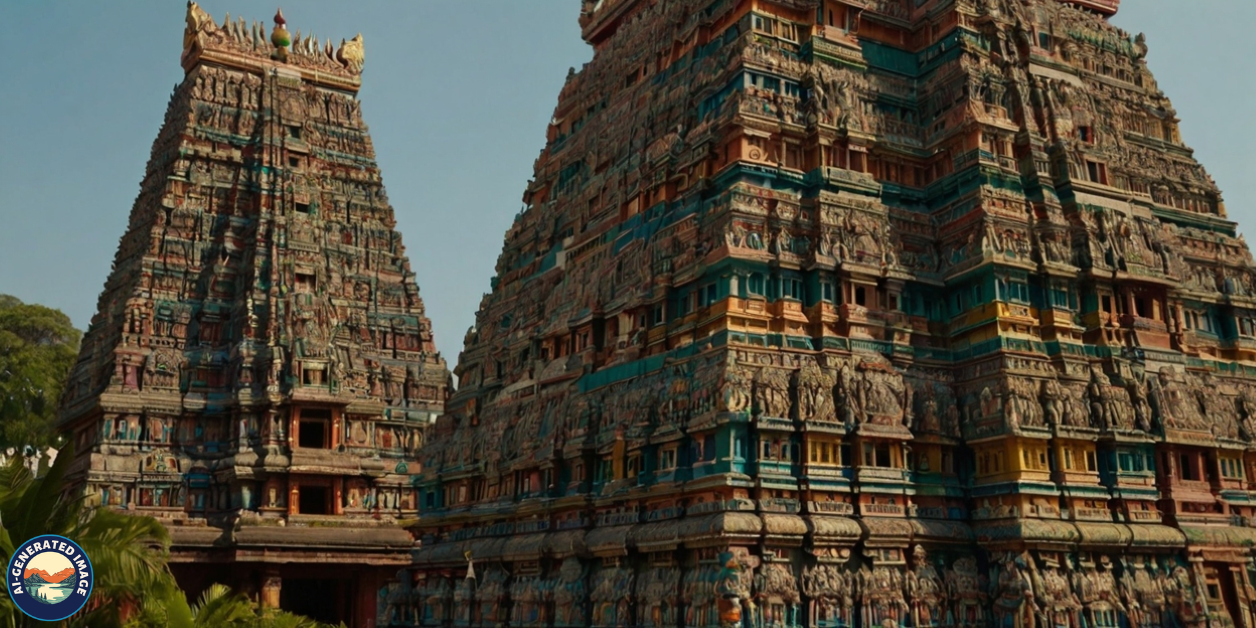Introduction
The Meenakshi Amman Temple is an iconic and deeply revered Hindu temple located in Madurai, Tamil Nadu, India. This temple, with its incredible Dravidian architecture, elaborate carvings, and vibrant history, is one of the most visited pilgrimage sites in the country.
Overview
Location and Cultural Significance
Situated in the heart of Madurai, the Meenakshi Amman Temple is an integral part of Tamil Nadu’s cultural and spiritual identity. It attracts millions of visitors each year who come to pay homage to the goddess Meenakshi and explore the temple’s stunning architecture.
Brief History of the Temple
The temple’s origins trace back to ancient times, with legends saying it was originally built by the Pandya King Malayadhwaja and his queen Kanchanamalai. While it underwent significant renovations and additions over centuries, much of the current structure is from the 12th to 16th centuries, with contributions from the Nayak rulers.
Architectural Marvel
The Unique Dravidian Style
The Meenakshi Amman Temple epitomizes the Dravidian architectural style that defines South Indian temples. Its towering gopurams (gateways) and complex layouts reflect the intricate artistry and attention to detail characteristic of this style.
Gopurams – The Towering Gateways
The temple is renowned for its twelve towering gopurams. The South Tower, standing at around 170 feet, is the tallest and most grandiose. Each gopuram is adorned with thousands of brightly painted sculptures depicting gods, goddesses, and mythological scenes.
Intricate Sculptures and Carvings
Every corner of the Meenakshi Amman Temple is embellished with intricate carvings that tell stories from Hindu mythology. Visitors are often captivated by the vibrant colors and lifelike depictions that bring these ancient tales to life.
Temple Interiors – A Closer Look
Inside, the temple is an expanse of beautifully painted ceilings, intricate wall carvings, and large corridors that lead to various shrines. The interiors are equally stunning, reflecting the same attention to detail as the exteriors.
Hall of Thousand Pillars
Structural Grandeur of the Hall
One of the temple’s most impressive structures is the Hall of Thousand Pillars, also known as the Aayiram Kaal Mandapam. This hall is supported by precisely 985 intricately carved pillars.
Artistic Excellence of the Pillars
Each pillar in this hall is a masterpiece, showcasing carvings that represent deities, legendary events, and mythical animals. These carvings are so intricate and varied that no two pillars look the same, making it a mesmerizing place for visitors and historians alike.
Deities of Meenakshi Amman Temple
Goddess Meenakshi
At the heart of the temple lies the shrine dedicated to Goddess Meenakshi, the warrior goddess and consort of Lord Shiva. She is depicted with a fish-eyed beauty and a compassionate expression, embodying grace, power, and divinity.
Lord Sundareswarar
The temple also honors Lord Sundareswarar (a form of Shiva), who is said to have married Meenakshi in a grand celestial wedding. The shrines of Meenakshi and Sundareswarar symbolize harmony and marital bliss.
Other Important Deities
Apart from Meenakshi and Sundareswarar, the temple complex includes several smaller shrines for other deities, offering visitors a chance to witness a wide array of religious symbols and figures.
Rituals and Festivals
Daily Rituals and Offerings
The temple has a rich tradition of daily rituals that start as early as 5:00 AM. Offerings of flowers, incense, and prayers are made, and devotees partake in rituals that fill the temple with a sacred ambiance.
The Magnificent Meenakshi Thirukalyanam Festival
The Meenakshi Thirukalyanam, or Celestial Wedding Festival, is the grandest celebration at the temple, drawing thousands of devotees every April. It celebrates the divine marriage of Meenakshi and Sundareswarar with fervor and joy.
Key Highlights of the Festival
Highlights include colorful processions, music, dance, and elaborate decorations. During this festival, the temple is adorned with flowers, lights, and traditional art.
Participation and Importance for Devotees
For devotees, participating in the Thirukalyanam festival is seen as a blessing. They believe it strengthens marital harmony and brings prosperity to families.
Tourist Guide
Best Time to Visit
The best time to explore the temple is from October to February, as the weather is pleasantly mild during these winter months. April is also popular for the Meenakshi Thirukalyanam festival.
Dress Code and Visitor Etiquette
Guests should dress modestly, ensuring their shoulders and knees are covered. Following respectful behavior and maintaining silence in the inner sanctums is also encouraged.
Entry Fees and Timings
The temple has specific visiting hours, generally from 5:00 AM to 12:30 PM and from 4:00 PM to 9:30 PM. Entry is free, but certain parts may have nominal charges.
Exploring Nearby Attractions
Nearby, you’ll find Thirumalai Nayakkar Mahal, Gandhi Memorial Museum, and Vaigai Dam for a deeper dive into Madurai’s heritage.
Spiritual and Cultural Importance
Religious Significance
The temple is not only a place of worship but also a symbol of Tamil culture and Dravidian heritage. It celebrates the divine feminine and embodies themes of unity and reverence.
Architectural Influence on South Indian Temples
The architectural techniques and designs of Meenakshi Temple have inspired other temples across South India, making it a blueprint for future generations.
Conclusion
In summary, Meenakshi Amman Temple is a spiritual oasis and architectural gem that speaks to the rich culture of South India. Whether you’re drawn by spirituality, architecture, or history, this temple has something special to offer.
FAQs
1: When is the ideal time of year to plan a visit?
Winter months, from October to February, are ideal, while April is festive with the Meenakshi Thirukalyanam.
2: Are non-Hindus allowed inside the temple?
Yes, non-Hindus are welcome, but certain inner sanctums may have restricted access.
3: How long does it take to explore the temple thoroughly?
Visitors often spend 2-4 hours exploring the temple, especially if interested in details and architecture.
4: Is photography allowed inside the temple?
Photography is restricted inside certain parts of the temple, especially around the shrines.
5: What are some nearby attractions worth visiting?
Notable sites nearby include the Thirumalai Nayakkar Mahal, Gandhi Memorial Museum, and Vaigai Dam.

